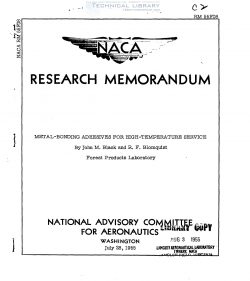naca-rm-55f08
- Version
- 100 Downloads
- 1.07 MB File Size
- 1 File Count
- October 9, 2017 Create Date
- October 9, 2017 Last Updated
National Advisory Committee for Aeronautics, Research Memorandum - Metal Bonding Adhesives for High Temperature Service

The results of an investigation.made for the purpose of developing
a metal-bonding adhesive with improved heat—resistant properties are
reported. The most promising results were obtained with a formulation
of a phenol resin and an epoxy resin with certain heat stabilizers and
catalysts. The formulation has high resistance to aging at 550° F and
is particularly promising in tape form.for bonding sandwich construc-
tions. An improved straight epoxy—resin adhesive that has superior
strength properties at 250° to 5000 F compared with any other known
epoxy-resin adhesive formulation is also reported.
This report presents one phase of an investigation of experimental
adhesive formulations with improved performance and heat—resistant prep—
erties for structural bonding of metal to metal in aircraft fabrication
which has been conducted at the Forest Products Laboratory under the
sponsorship and with the financial assistance of the National Advisory
Committee for Aeronautics. Particular attention has been given to the
development of adhesives of phenol and epoxy resins that are less sensi—
tive to variations in bonding techniques and that have better strength
in Joints over the range of -700 to 6000 F. Earlier results of this
investigation have been reported in.references l and 2.
Reference 1 described adhesive FPLpTlO, an adhesive that developed
promising shear strength when tested at temperatures up to 600° F and
possessed good resistance to aging at temperatures as high as #500 F.
The principal limitations of adhesive FPL—TlO were that it was somewhat
brittle, it possessed marginal bending and fatigue strength and variable
performance at 6000 F, and the optimum film.thickness for bonding
(0.002 inch) was too thin for practical use in aircraft. Reference 2
described further work on and development of FPL-710 adhesive. The
variable performance in immediate tests at 600° F was improved by post—
curing the adhesive and by impregnating it into a glass-mat carrier to
form a tape adhesive. The tape adhesive increased the optimum film
thickness for bonding to 0.010 inch, which made it more practical in
industrial bonding applications. The resistance of adhesive FPL—710 to e
aging at 550° F was also improved by the addition of certain chelating
agents to the adhesive mixture. The tape adhesive, however, was still
quite brittle, and low resistance to peel, was somewhat variable in its
performance after aging at 5500 F, and lacked adequate flow and fil—
leting action to be completely satisfactory for. the bonding of honey—
comb sandwich construction.
| File | Action |
|---|---|
| naca-rm-55f08 Metal Bonding Adhesives for High Temperature Service.pdf | Download |

Comment On This Post